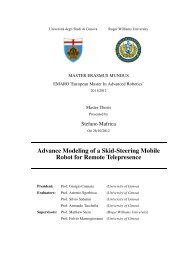SECCM Assessment Plan - Roger Williams University
SECCM Assessment Plan - Roger Williams University
SECCM Assessment Plan - Roger Williams University
Create successful ePaper yourself
Turn your PDF publications into a flip-book with our unique Google optimized e-Paper software.
• Course <strong>Assessment</strong> Report<br />
One of the most important instruments of the assessment process is course assessment report. Individual<br />
courses are the building blocks of the curriculum and most curricular changes are expressed in terms of<br />
courses. Course assessment is the process of measuring and evaluating the performance of a course<br />
against published course objectives and program outcomes. Integral to the process is the identification and<br />
implementation of strategies designed to improve the course.<br />
The course assessment report is a written document prepared for every course, every semester by the<br />
faculty member. These reports are prepared as soon after completion of the semester as possible.<br />
Identification of suggested changes arising from assessment, actions taken in response to assessment,<br />
and the efficacy of earlier actions resulting from the ongoing assessment process are all described in the<br />
course assessment report. Presented as a package, a set of consecutive course assessment reports<br />
presents a clear record of the course assessment process, changes and results. The course assessment<br />
report consists of three sections: the course description, the course assessment, and the course<br />
recommendations. Minimum content requirements for each section are prescribed by memorandum.<br />
Responsible faculty members may include additional data as desired. Upon completion, the reports are<br />
forwarded to the Dean where they are reviewed and catalogued.<br />
• Course Binder<br />
Prepared during the record years of ACCE and ABET accreditation visits, these binders provide a detailed<br />
view into course objectives, course organization, course focus and student performance. The binders are<br />
divided into three sections: Course Administration and <strong>Assessment</strong>; Course Examinations; and, Design<br />
Problems, Computer Problems, Laboratory Reports and Homework.<br />
• Course Student Survey<br />
Beginning in Academic Year 2001-2002, all student surveys were collected for all courses. (Prior to this<br />
time, only courses taught by probationary faculty, faculty scheduled for post-tenure review, or faculty<br />
members who volunteered to participate were surveyed.) A comprehensive instrument, questions<br />
investigate course content and quality, instructor performance, and perceived educational value. Course<br />
student survey results are compiled each semester. Instructors receive results for each of their courses and<br />
aggregate data are made available to the <strong>SECCM</strong> allowing the instructor to compare his or her course<br />
performance to the <strong>SECCM</strong> average.<br />
• Graduate Employers<br />
Employers who hire <strong>SECCM</strong> graduates provide a continuous source of feedback on the quality of program<br />
and its graduates. This feedback comes in two primary forms: informal discussion with <strong>SECCM</strong> faculty<br />
members and employer willingness to hire additional graduates. Employers tend to be frank about<br />
perceived program strengths and weaknesses. Data are collected at a variety of venues to include Career<br />
Fairs, the Senior Design and Construction Showcase, student competitions, professional association<br />
meetings, internship evaluation surveys and meetings of the Professional Advisory Board.<br />
• Professional Advisory Board Meetings<br />
The Professional Advisory Board provides an important source of program assessment. One of the<br />
important roles of the advisory boards is to periodically assess the curriculum to ensure its relevancy with<br />
regards to current industry needs and trends, Furthermore, since many of the advisory board members<br />
represent companies that hire graduates and employ interns, these individuals also provide input as<br />
Graduate Employers and through the Internship Program. Due to the close relationship enjoyed between<br />
advisory board members and program faculty members, assessment input tends to be very candid and<br />
offered with a comprehensive understanding of the mission and objectives of the program.<br />
10
















